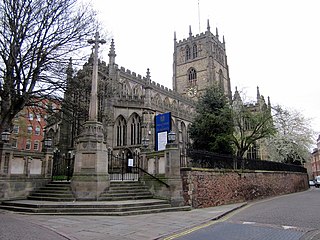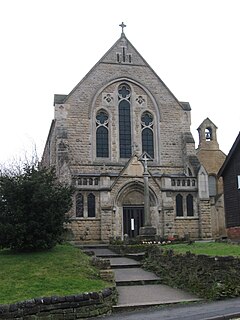
The Cathedral Church of St. Barnabas in the city of Nottingham, England, is a cathedral of the Roman Catholic Church. It is the mother church of the Diocese of Nottingham and seat of the Bishop of Nottingham. The cathedral is also grade-II* listed building.

The Cathedral of St. John the Baptist is located in the city of St. John's, Newfoundland and Labrador, Canada.

The Cathedral Church of St. John the Evangelist, usually known as Salford Cathedral, is a Catholic cathedral on Chapel Street in Salford, Greater Manchester, England. It is the seat of the Bishop of Salford and mother church of the Diocese of Salford, and is a Grade II* listed building.

All Saints' Church, Nottingham, is an Anglican church in Nottingham, England.

St Peter's Church, formally The Church of St Peter with St James, is an Anglican parish church in the city centre of Nottingham, England. It is part of the parish of All Saints', St Mary's and St Peter's, Nottingham.

St. John the Baptist Church is an Anglican church in Beeston, Nottinghamshire, England.

St. Stephen's Church, Sneinton is a parish church in the Church of England.

St George in the Meadows is a parish church in the Church of England in The Meadows, Nottingham, England.

Holy Trinity Church, Lenton is a parish church in the Church of England Diocese of Southwell.

St Peter's Church, Radford is a parish church in the Church of England in Radford, Nottingham. Address: 171 Hartley Rd, Nottingham NG7 3DW, UK.

The Church of St Mary the Virgin is the oldest religious foundation in the City of Nottingham, England, the largest church after the Roman Catholic Cathedral in Nottingham and the largest mediaeval building in the city.
St. Paul's Church, George Street, was a Church of England church built as a chapel of ease to St. Mary's Church, Nottingham. It was opened in 1822 and closed in 1924.

Holy Trinity Church, Nottingham was a Church of England church in Nottingham from 1841 to 1958.
St Mark's Church, Nottingham, was a Church of England church in Nottingham, UK, between 1856 and 1958. The section of Huntingdon Street where the church was located was formerly called Windsor Street.
Emmanuel Church, Nottingham was a Church of England church in Nottingham on Woodborough Road between 1883 and 1972.

St Christopher's Church, Sneinton is a Church of England church in Sneinton Nottingham.

St. Paul's Church, Hyson Green is a former Church of England parish church in Hyson Green, Nottingham.

St Peter's Church, Belper is a Grade II listed parish church in the Church of England in Belper, Derbyshire.

Holy Trinity Church, Matlock Bath is a Grade II listed parish church in the Church of England in Matlock Bath, Derbyshire.

Holy Trinity Church is a Grade II listed parish church in the Church of England in Shirebrook, Derbyshire.

















